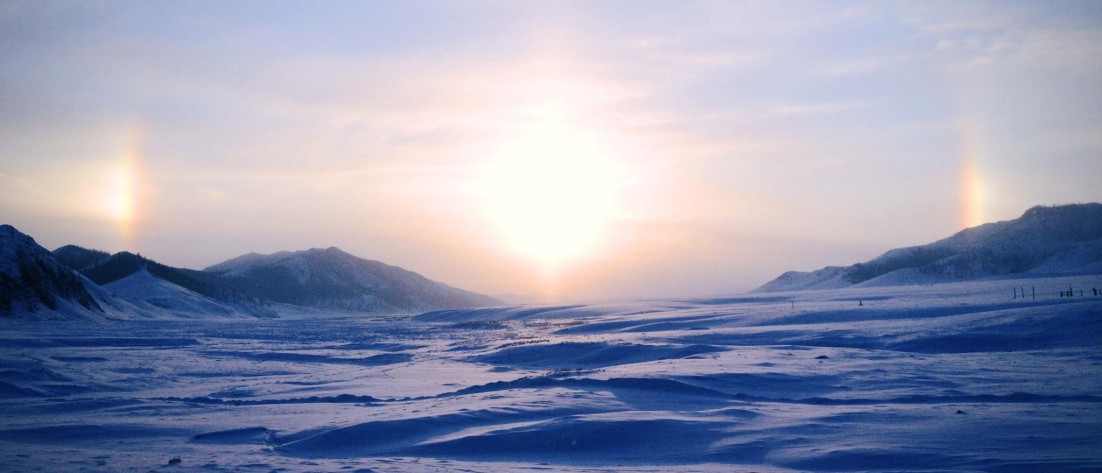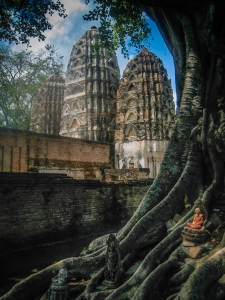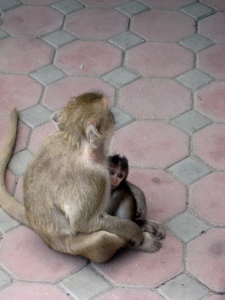After all the difficulty in getting to Phitsanulok, I was in the city for a remarkably short time. I’d planned on spending a day there before moving on to Sukhothai, but a closer look at the guidebook and the knowledge that I’d lost a day in Lopburi convinced me to skip it. So after a night in an unremarkable hotel, I bought a ticket for the first hour-long bus ride of the morning to Sukhothai.
A kingdom in its own right 150 years before Ayutthaya rose to prominence and a modern UNESCO World Heritage Site, Sukhothai had been on my must-see list from the get-go. Thai children are taught that this is where King Ramkhamhaeng invented the Thai script, though the archaeological record apparently casts some doubt upon this story. Still, I wasn’t about to question the history books (aloud, anyway) in a country where lèse majesté is still an imprisonable offense, and as we’ve established, I’m a sucker for palace and temple ruins. Sukhothai promised both, and plenty of them.
I even found myself a couple of travel companions with whom to visit them. There were two guys in their twenties on the same bus—one from America, the other from France. We introduced ourselves while waiting for the bus and told stories about the other places we’d traveled during the ride. By the time we reached our destination, we’d decided to stick together for the next day or two.
After pooling our resources to “splurge” on an air-conditioned room in a lovely little guesthouse, we took advantage of the free bikes to explore the town. Lacking the river boundaries, Sukhothai has spread quite a bit more than Ayutthaya in the past 700 years. Instead of residing atop its past, New Sukhothai is distinct from Old Sukhothai, and the latter is contained within a historical park. Since we’d already lost most of the morning, we decided to postpone our visit until the next day and made a haphazard circuit of the city, eventually working our way over to the impressive Phra Mae Ya Shrine. It houses an idol dedicated by King Ramkhamhaeng to his mother—and, according to local belief, the spirit of the great king himself.
As was so often the case in Thailand, the shrine proved too large for me to get a good picture of the whole structure; if I managed to get all five of the towers into the shot, it also included undesirable items like street lights. Happily, our visit to the historical park the next day gave me much more camera fodder!
Wat Mathathat is the largest and most important set of ruins, and also the closest to the park entrance. This “temple of the great relic” was great indeed: the intervening centuries have stripped away the gilt and glitz the buildings must have had when first built, but their scale and grandeur remain undiminished.
Large and imposing as this complex was, however, it was only the beginning of what the park had to offer. While the boys and I opted not to pay the admission fees for any but the central zone, we did rent bikes in order to visit as much of that zone as possible. Sometimes, this meant a long trek around large moats that afforded a spectacular view, while at others, we crossed smaller moats to more intimate-feeling temples like the lovely Wat Sa Si.
What I really appreciated as I wandered through the park was the complexity of the structures it contained and the emotions they evoked. While I wasn’t sufficiently versed in Thai architectural history to know from the shape of a chedi the era in which it was built, even I could see from the many subtle variations in design that they bore witness to the preferences of different time periods and ruling peoples. Nor did I have to know whether a chedi was Lanna, Lanka, etc. to appreciate its many facets. Even the most massive temples boasted intricate adornments not yet lost to the erosion of time. Recent visitors had also added to these monuments in unexpected ways: not with the offerings I’d grown used to seeing in Mongolia, but with little Buddha figurines tucked into unexpected corners.
Just as in the majestic cathedrals of Europe, I found myself in a contemplative state of mind while wandering the park. Even teeming with noisy tourists, there was something meditative about these spaces. You can only witness the silent, stone serenity of so many seated Buddhas before you either grow twitchy with boredom or fall under the spell yourself. And in a place this gorgeous, who could ever be bored?


















 Even there, we weren’t entirely safe. The fence was there to keep the tourists out; it did nothing whatsoever for the monkeys. They were everywhere in this part of the town: roaming the streets, lazing on the sidewalks, walking the power lines, even invading some of the ground-floor stores. I snapped a few pictures of the admittedly adorable babies but quickly discovered what the locals already know: they are clever, mischievous pests, made all the more pestilential by their intelligence and opposable thumbs. What I really wanted was a monkey stick, one of those long bamboo rods the shopkeepers used to to keep the macaques at bay without coming in range of their teeth. Lacking such a device, I tread amongst them with care. Never have I been so aware of my lack of a rabies vaccination as I was as I made my slow way through the monkey gauntlet, doing my utmost not step on anyone’s tail.
Even there, we weren’t entirely safe. The fence was there to keep the tourists out; it did nothing whatsoever for the monkeys. They were everywhere in this part of the town: roaming the streets, lazing on the sidewalks, walking the power lines, even invading some of the ground-floor stores. I snapped a few pictures of the admittedly adorable babies but quickly discovered what the locals already know: they are clever, mischievous pests, made all the more pestilential by their intelligence and opposable thumbs. What I really wanted was a monkey stick, one of those long bamboo rods the shopkeepers used to to keep the macaques at bay without coming in range of their teeth. Lacking such a device, I tread amongst them with care. Never have I been so aware of my lack of a rabies vaccination as I was as I made my slow way through the monkey gauntlet, doing my utmost not step on anyone’s tail. In all respects but one, though, I made my way through the city without incident. My bandaged hand drew a lot of attention throughout the day, and I found myself continually having to explain that it was not (thankfully!) from a monkey bite. The nurses at the clinic I visited in the afternoon were among those who asked the question. I’d been instructed to have the bandages on my hand rewrapped every day, and while that seemed like overkill, the sheer difficulty of keeping the gauze clean and neat convinced me to have it done at least on that first day.
In all respects but one, though, I made my way through the city without incident. My bandaged hand drew a lot of attention throughout the day, and I found myself continually having to explain that it was not (thankfully!) from a monkey bite. The nurses at the clinic I visited in the afternoon were among those who asked the question. I’d been instructed to have the bandages on my hand rewrapped every day, and while that seemed like overkill, the sheer difficulty of keeping the gauze clean and neat convinced me to have it done at least on that first day.



















































